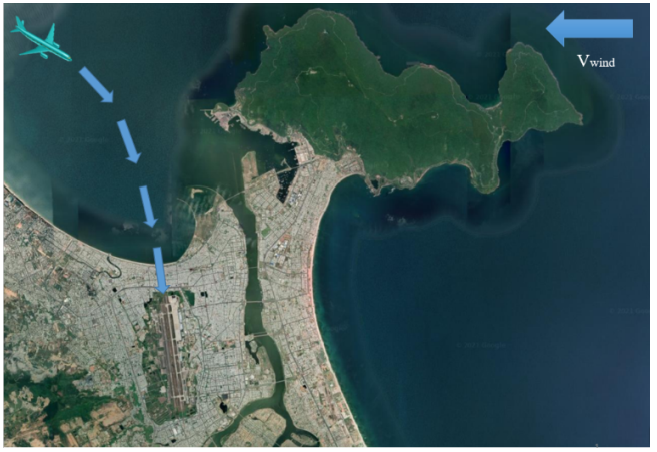Study of aerodynamic characteristics of an aircraft during approach to landing in a disturbed atmosphere
Author affiliations
DOI:
https://doi.org/10.15625/0866-7136/16760Keywords:
coherent vortex structures in the atmosphere, flight safety, Reynolds-averaged Navier-Stokes equations, computational fluid dynamics, boundary element methodAbstract
An approximate method is proposed for determining the aerodynamic effect of coherent vortex structures (CVS) of atmospheric turbulence on an aircraft. As a source of the CVS the vortex wind wakes arising when the atmospheric wind flows around the mountain massif of the Son Tra peninsula, located near the Da Nang airport, and the vortex wake behind the Su-27 type aircraft in the landing configuration are considered. Modeling the formation of a vortex structure is carried out by the grid method within the framework of the boundary value problem for the Reynolds-averaged Navier—Stokes equations. The evolution and stochastics of the far wake are modeled in a two-dimensional approximation by discrete Rankine vortices. The assessment of the increment of forces and moments from the effect of the vortex system on the aircraft was carried out within the framework of the panel method. The situation is considered when a light transport aircraft gets into a vortex wake behind an aircraft with a swept wing and a passenger aircraft of the MS-21 type, approaching for landing at the CVS from a mountainous terrain.
Downloads
References
A. V. Bobylev, V. V. Vyshinsky, G. G. Soudakov, and V. A. Yaroshevsky. Aircraft vortex wake and flight safety problems. Journal of Aircraft, 47, (2010), pp. 663–674.
G. R. Barri. Weather and climate in the mountains. L.: Gidrometeoizdat, 311 p., (1984). (in Russian).
S. S. Zilitinkevich. The dynamics of the atmospheric boundary layer. L.: Hydrometeorological Publishing, 292 p., (1970). (in Russian).
L. P. Bykov. The application of the atmosphere boundary layer model above the complex surface to the study of breeze circulation. In Proceedings of the Main Geophysical Observatory, Vol. 454, (1981), pp. 97–108. (in Russian).
D. L. Laikhtman. The physics of the atmospheric boundary layer. L.: Gidrometeoizdat, 341 p., (1970). (in Russian).
G. S. Rivin, I. A. Rozinkina, A. N. Bagrov, and D. V. Blinov. The mesoscale model COSMO-RU 07 and the results of its operational tests. In Information Collection, Vol. 39, (2012), pp. 15–48.
D. Majewski, D. Liermann, P. Prohl, B. Ritter, M. Buchhold, T. Hanisch, G. Paul, W. Wergen, and J. Baumgardner. The operational global icosahedral–hexagonal gridpoint model GME: Description and high-resolution tests. Monthly Weather Review, 130, (2002), pp. 319–338.
https://grabcad.com/library/su-27-2017-model-edf-70mm-1.
T. O. Aubakirov, A. I. Zhelannikov, P. E. Ivanov, and M. I. Nisht. Tracks and their impact on aircraft. Modeling on the computer, Almaty, 280 p., (1999). (in Russian).
A. S. Ginevsky and A. I. Zhelannikov. Vortex wakes of aircraft. In Moscow: FIZMATLIT, 172 p., (2008). (in Russian).
V. V. Vyshinsky and K. T. Zoan. Numerical simulation of the flow around landscape fragments and solution verification. TsAGI Science Journal, 51, (6), (2020), pp. 641–650.
P. Roach. Computational fluid dynamics. M.: Mir, 616 p., (1980).
V. Anikin, V. Vyshinsky, O. Pashkov, and E. Streltsov. Using the maximum pressure principle for verification of calculation of stationary subsonic flow. Herald of the Bauman Moscow State Technical University. Series Mechanical Engineering, (2019), pp. 4–16.
V. V. Vyshinsky and G. B. Sizykh. The verification of the calculation of stationary subsonic flows and the presentation of results. Mathematical Models and Computer Simulations, 11, (2019), pp. 97–106.
V. V. Vyshinsky and K. T. Zoan. Aircraft aerodynamics in a disturbed atmosphere. Proceedings of Moscow Institute of Physics and Technology, 13, (2), (2021), pp. 40–48.
Y. N. Sviridenko and Y. L. Ineshin. Application of the panel method with symmetrization of features to the calculation of the flow around an aircraft, taking into account the influence of engine jets. In Proceedings of TsAGI, number 2622, (1996), pp. 41–53. (in Russian).
Y. S. Mikhailov. Modeling the impact of a vortex wake on an aircraft model in a wind tunnel. Scientific Bulletin of MSTU GA, (175), (2012), pp. 62–69. (in Russian).
Y. S. Mikhailov. Vortex wake simulation in a wind tunnel. In Proceedings of TsAGI, number 2641, (1999), pp. 197–203.

Downloads
Published
How to Cite
Issue
Section
License

This work is licensed under a Creative Commons Attribution-ShareAlike 4.0 International License.









